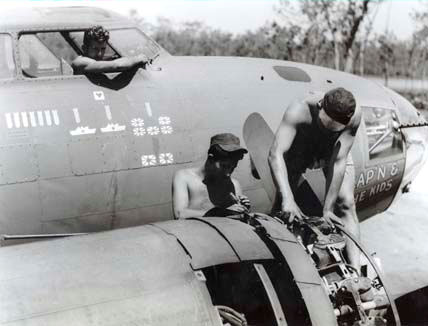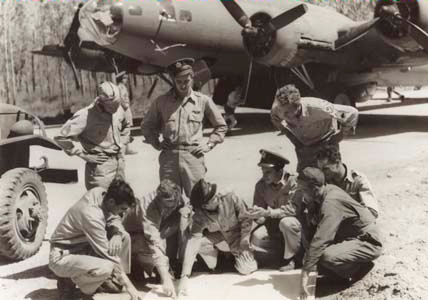"CAP'N & THE
KIDS"
B-17 FLYING FORTRESS
IN AUSTRALIA DURING WW2
![]()
“Cap’n
and the Kids”
Tail
No. 41-24353
by 1st
Lt.
Chris Melton
68th Airlift Squadron
On 11 June 1942, a B-17 Flying Fortress (tail number #41-24353) was delivered to the 63rd Bomb Squadron (43rd Bomb Group). Named “Cap’n and the Kids”, the aircraft was flown to Australia by Lt James T. Murphy. Shortly after arriving in the Pacific Theater, Captain Edward W. Scott, Jr. (a pioneer of skip-bombing tactics), was assigned to her as pilot.
“Cap’n and the Kids” would tally up an impressive record while fighting against the Imperial Forces of Japan. She sank two Japanese ships on a single bombing run on 13 March 1943. On this occasion, Scott picked a 4,000 ton tanker and made a low level skip-bombing run from an altitude of 200 feet. Scott “skipped” his bombs into his target. The Japanese ship was seen bursting apart. Scott continued his bombing run at the same altitude and selected another victim. Once again the bomber scored hits which caused explosions on both sides of the enemy vessel. This deadly bomber would make her last flight with the 63rd Bomb Squadron on 18 October 1943 when she served as a "weather ship" on an aborted bombing mission to Rabaul. She was then sent to the “bone yard” as the Squadron began receiving their new B-24 Liberators.
“Cap’n and the Kids” sat on the field with the 4th Air Depot Group at Garbutt Field in Townsville, Australia. Although, she defiantly displayed the many badges of combat on her nose, (94 bombs drops, five enemy fighters and 8 ships), she was cannibalized for parts and unflyable. Salvation would come, however, when she was selected for a new mission. In November of 1943, the old bomber was modified to serve in the capacity as an armed transport. The bomb racks and shackles were removed and replaced by two aluminium canisters suited for air drops. The underside of each canister was fastened with hinges which were electrically operated with T-Handles by the Pilot. Although the ball turret was removed, all the other gun positions were kept. After the necessary modifications, the Cap’n was assigned to the 69th Troop Carrier Squadron, 433rd Troop Carrier Group on 23 February 1944. 5th Air Force was receiving requests for airdrops in areas where unarmed C-47’s wouldn’t dare venture. With this reborn bomber, it was now possible to supply troops at the forward lines of battle.
The “Cap’n and the Kids” was flown next by Capt. Ulysses S. Algee as Pilot and Co-pilot James Liptak of the 69th Troop Carrier Squadron. On one particular mission, Mr. Liptak recalls, the aircraft and her crew were tasked to a small island in the Admiralties named Momote. The mission required that the crew airdrop supplies to some Marines who had recently taken a small airstrip. The ousted Japanese forces concentrated their forces in a large coconut grove on the opposite side of the strip preventing unarmed transport aircraft from landing. Basically the runway was “no-man’s land”, but the Marines requested the drop on the runway and the Cap’n was happy to oblige. The large bomber made a high speed pass and dropped the supplies while taking small arms fire from the trees. Once the Marines tried to retrieve their supplies, enemy fire opened up on them as well sending them back for cover. With the supplies unclaimed on the strip, the Marines radioed to the Cap’n for her assistance. The B-17 then made another pass (this time over the coconut grove) and strafed the enemy positions. On this pass the gunners used up most of their precious ammunition for her defence but they were pleased to have helped out.
The Marines retrieved their supplies and the Cap’n climbed out to twenty thousand feet for the return flight home. Suddenly the right waist gunner called out, “five Japs, nine O’clock high.” Five Tony fighters were on a patrol in the area had spotted the unescorted. Captain Algee frantically radioed for the assistance of allied fighters in the area.
The lead Japanese aircraft couldn’t resist the temptation of a lone bomber and peeled off for an attack 90 degrees to the bomber’s right. Things didn’t work out in his favour, however. The right waist gunner hammered the fighter with his remaining ammunition as he closed in. The wounded Tony passed overhead the Cap’n making him an easy target for the left waist gunner who finished him off easily! Seeing their lead aircraft shot down, the remaining four fighters hesitated in pressing their luck with the deadly bomber. It didn’t take long for a flight of P-39’s to intercept them and ruin their day as well shooting them all down. The two waist gunners given credit for the shoot down were from the 67th Troop Carrier Squadron.
The "Cap’n and the Kids" would claim one more Japanese fighter for the 433rd TCG on another air drop mission to Hollandia. The aircraft would remain in the service of the Group until August of 1944. Then the aircraft would suddenly be taken away from the Group.
The role of the B-17 serving with the troop carrier squadrons would come to an end when stories of mischievous flying activities filtered back to the 5th Air Force. Allied forces during the war isolated many of the large Japanese positions by cutting their lines of supply and reinforcements. Cutoff from the outside world (with no one to fight), over a hundred thousand Imperial troops would be left to starve and wallow in combat ineffectiveness. Apparently, an unidentified B-17 from a troop carrier outfit was dumping trash over the Japanese field of Wewak. It was learned that the Japanese were eating the trash thus undermining General Douglas MacArthur’s grand strategy. It wouldn’t take long for the B-17’s to be unceremoniously taken away from the troop carriers.
The story was not over for the Cap’n however. The veteran bomber was next assigned to the Eighth Army Commander General Robert L. Eichelberger. Eichelberger renamed the veteran bomber Miss Em' for his wife, Emaline and had all of the proud and deserved badges of war removed from her nose. With a nose clean and void of the testimonies of aerial achievement, Major Charles Downer was assigned to her as the new pilot. He signed for her at Townsville on 11 September 1944 and three days later flew her to Hollandia. Downer would fly 63 combat missions and 97 flights in 141 days. On 6 August l945, Downer’s last flight in 'Miss Em' was to Manila’s Nichols Field.
Throughout her long career, the veteran bomber received credit for flying 80 missions, sinking 8 enemy vessels, shooting down 10 Japanese fighters and making 94 bomb drops. With the war over, she was finally scrapped at Tacloban, Leyte in April of 1946, thus ending her distinguished service.
The story of “Cap’n and the Kids” was compiled through phone interviews with Mr. James Liptak of Spokane Washington and Mr. Jack Burns of Little Rock, Arkansas. Additionally, Mr. Jimmie Riche of Spring, Texas found excerpts of the Cap’n in a book he owns named “Backload”. Mr. Mark Styling of Dorset, England provided me with references from the book “Pride of Seattle, The Story of the First 300 B-17F’s” published by Squadron Signa and written by Steve Birdsall.
During my investigation of armed transports with troop carrier squadrons, I have found references concerning six B-17’s assigned to troop carrier squadrons. They are #41-2662 (Spawn of Hell), #41-2072(name unknown), #41-24353 (Cap’n and the Kids), #41-2357 (name unknown), #41-24381 (Panama Hattie) and #41-24420 (Super Snooper). Except for the “Cap’n and the Kids” I have not found enough information to tell the stories of these old bombers; however, I’m still looking!
 Photo:- NAA
Maintenance work on Cap'n & The Kids
|
 Photo:- NAA
Pointing to a Purple Heart emblem on
Cap'n & The Kids
|
 Photo:- NAA
Ground staff working on B-17 Cap'n & The Kids
|
The following photos of other B-17 Flying Fortresses are from the same collection as the above three photographs of B-17 Flying Fortress "Cap'n & The Kids". They were all taken at the same "base somewhere in Australia" .
 Photo:- NAA Another B-17 Taking off
|
 Photo:- NAA Crew of another B-17 plotting their course
|
 Photo:- NAA Action stations
|
 Photo:- NAA Waist gunner position in another B-17
|
 Photo:- NAA Another B-17 on the ground |
 Photo:- NAA Another B-17 returning to its base |

Photo:- via Matt Simmons
Data Plate for B-17 with Construction No 3038
Matt Simmons contacted me on 8 November 2013 to advise he had whet he believes to be the Data Plate from B-17 Flying Fortress
#41-24353. The Boeing Construction Number (C/N) for #41-24353 was 3038. .Matt found this plate in an American veteran's.This veteran pilot had arrived in the Pacific theater in August 1945 as the war was ending. He picked up a new C-46 Commando in California, landed 27 hours later in Hawaii on 7 Aug 1945. From there he hopped across several islands (Guadalcanal, New Guinea, Christmas Island) before being assigned to Clark Field, Philippines. He flew supply missions through 1946 and was assigned to a small field outside Tokyo by the summer of 1946. Matt presumes that while he was in the Philippines he 'acquired' this data plate off B-17 Flying Fortress #41-24353 "Miss Em" previously named
“Cap’n and the Kids” when it was being scrapped.

Photo:- Marty Upchurch Collection
B-17 Flying Fortress "Cap'n & The Kids"
ACKNOWLEDGEMENTS
I'd like to thank Christopher Melton, Matt Simmons and Steve Birdsall for their assistance with this web page.
Can anyone help me with more information?
"Australia @ War" WWII Research Products
|
© Peter Dunn 2015 |
Please
e-mail me |
This page first produced 5 March 2005
This page last updated 24 January 2020